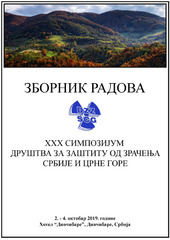Prikaz osnovnih podataka o dokumentu
Sadržaj radionuklida u mahovinama na području prigradskih opština grada Beograda
Content of radionuclides in mosses in the suburban areas of Belgrade city
| dc.creator | Mitrović, Branislava | |
| dc.creator | Ajtić, Jelena | |
| dc.creator | Grdović, Svetlana | |
| dc.creator | Vranješ, Borjana | |
| dc.date.accessioned | 2022-01-17T10:13:07Z | |
| dc.date.available | 2022-01-17T10:13:07Z | |
| dc.date.issued | 2019 | |
| dc.identifier.isbn | 978-86-7306-154-2 | |
| dc.identifier.uri | https://vet-erinar.vet.bg.ac.rs/handle/123456789/2373 | |
| dc.description.abstract | Mahovine spadaju u grupu bioindikatorskih organizama, jer apsorbuju radionuklide iz padavina i suve depozicije. Kao dobri pokazatelji radioaktivnog zagaĎenja, u ovom radu mahovine su iskorišćene da se odredi sadrţaj prirodnih radionuklida 40K, 238U, 226Ra, i 232Th, kao i proizvedenog 137Cs, na području četiri prigradske opštine grada Beograda: Palilula, Zemun, Rakovica i Lazarevac. Uzorci mahovina sa drveća sakupljeni su tokom proleća i jeseni 2010. godine. Posle sušenja i usitnjavanja, uzorci su mereni na niskofonskom High Purity Germanium detektoru relativne efikasnosti 30,3%. Izmerene specifične aktivnosti radionuklida su: 155-270 Bq/kg za 40K, MDA-38 Bq/kg za 238U, 5,8-41 Bq/kg za 226Ra, 5,4-25 Bq/kg za 232Th i 18-166 Bq/kg za 137Cs. IzmeĎu ispitivanih lokacija postoje razlike u sadrţaju radionuklida u mahovinama. Na primer, najveći sadrţaj prirodnih radionuklida 238U, 226 Ra i 232Th detektovan je u mahovinama na lokalitetu Zemun, a najmanji na području Palilule, dok je najveći sadrţaj antropogenog radionuklida 137Cs detektovan na području opštine Lazarevac (160 Bq/kg), a najniţi na teritoriji opštine Palilula (21 Bq/kg). | sr |
| dc.description.abstract | Mosses are biondicators of environmental pollution because they absorb radionuclides from precipitation and dry deposition. In this paper, the ability of mosses to absorb and accumulate radionuclides is used to determine the content of naturally occurring 40K,238U, 226Ra and 232Th, and an artificial 137Cs, in the suburban areas of Belgrade city: themunicipalities of Palilula, Zemun, Rakovica and Lazarevac. Samples of moss were collected from trees during the spring and autumn 2010. After drying and milling, the samples were measured at a low-level HPGe detector, relative efficiency of 30.3%. The measured specific activities are: 155-270 Bq/kg for 40K, MDA-38 Bq/kg for 238U, 5.8-41 Bq/kg for 226Ra, 5.4-25 Bq/kg for 232Th and 18-166 Bq/kg for 137Cs. The obtained results show differences in the content of radionuclides in mosses across the investigated sites. For example, the highest content of naturally occurring 238U, 226Raand 232Th is detected in mosses in Zemun, and the lowest in Palilula, while the highestcontent of the anthropogenic 137Cs is detected in the municipality of Lazarevac (160 Bq/kg), and the lowest in the municipality of Palilula (21 Bq/kg). | |
| dc.language.iso | sr | sr |
| dc.publisher | Institut za nuklearne nauke „Vinča" | sr |
| dc.relation | info:eu-repo/grantAgreement/MESTD/Technological Development (TD or TR)/31003/RS// | sr |
| dc.relation | info:eu-repo/grantAgreement/MESTD/Technological Development (TD or TR)/34013/RS// | |
| dc.relation | info:eu-repo/grantAgreement/MESTD/Integrated and Interdisciplinary Research (IIR or III)/43007/RS// | |
| dc.rights | openAccess | sr |
| dc.source | Zbornik radova sa XXX Simpozijuma Društva za zaštitu od zračenja Srbije i Crne Gore, 2–4. oktobar, 2019, Divčibare, Srbija | sr |
| dc.title | Sadržaj radionuklida u mahovinama na području prigradskih opština grada Beograda | sr |
| dc.title | Content of radionuclides in mosses in the suburban areas of Belgrade city | |
| dc.type | conferenceObject | sr |
| dc.rights.license | ARR | sr |
| dc.citation.spage | 53 | |
| dc.citation.epage | 57 | |
| dc.identifier.fulltext | http://veterinar.vet.bg.ac.rs/bitstream/id/6562/bitstream_6562.pdf | |
| dc.identifier.rcub | https://hdl.handle.net/21.15107/rcub_veterinar_2373 | |
| dc.type.version | publishedVersion | sr |
| dc.identifier.cobiss | 279687436 |

